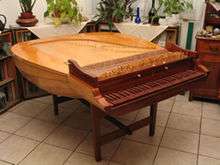Lautenwerck

The lautenwerck (also spelled lautenwerk), or lute-harpsichord (lute-clavier), was a European keyboard instrument of the Baroque period. It was similar to a harpsichord, but with gut rather than metal strings, producing a mellow tone.
The instrument was favored by J. S. Bach, who owned two of the instruments at the time of his death, but no specimens from the 18th century have survived to the present day.[1] It was revived in the 20th century by harpsichord makers Willard Martin, Keith Hill and Steven Sorli. Two of its most prominent performers are the early music specialists Gergely Sárközy and Robert Hill.
Media
Performances by Martha Goldstein:
|
BWV 998 - Allegro
BWV 996 - Prelude-Presto
BWV 996 - Allemande
BWV 996 - Courante
BWV 996 - Sarabande
BWV 996 - Bourre
BWV 996 - Gigue
Problems listening to the files? See media help. |
Performances by Felix Skowronek (flute) with Martha Goldstein:
|
Flute Sonata in B minor BWV 1030 - 2. Largo e Dolce
Flute Sonata in B minor BWV 1030 - 3. Presto
Problems listening to the files? See media help. |
Performances by Gergely Sárközy are also freely available.[2]
Notes
- ↑ Henning, p. 477
- ↑ Including BWV 996 - Prelude-Presto and BWV 996 - Bourree, both via Archive.org
References
- Henning, Uta (October 1982). "The Most Beautiful Among the Claviers: Rudolf Richter's Reconstruction of a Baroque Lute-Harpsichord". Early Music. 10 (4): 477–486. doi:10.1093/earlyj/10.4.477. JSTOR 3126936.
External links
| Wikimedia Commons has media related to Lautenwerck. |
- Lautenwerck page
- Information (Tihamér Romanek)
- Gallery of pictures and sounds (Stevie Sorli)